Fires in Raised Bog: Their Influence and Changes to Geochemical Elements in Peat Layers
Abstract
:1. Introduction
2. Materials and Methods
3. Results
4. Discussion
5. Conclusions
Author Contributions
Funding
Data Availability Statement
Conflicts of Interest
References
- Morris, J.L.; Valiranta, M.; Sillasoo, U.; Tuittila, E.S.; Korhola, A. Re-evaluation of late Holocene fire histories of three boreal bogs suggest a link between bog fire and climate. Boreas 2014, 44, 60–67. [Google Scholar] [CrossRef]
- Bond, W.J.; Keeley, J.E. Fire as a global ‘herbivore’: The ecology and evolution of flammable ecosystems. Trends Ecol. Evol. 2005, 20, 387–394. [Google Scholar] [CrossRef] [PubMed]
- Belcher, C.M. Fire Phenomena and the Earth System: An Interdisciplinary Guide to Fire Science; John Wiley & Sons: Hoboken, NJ, USA, 2013; p. 579. [Google Scholar] [CrossRef]
- Kruger, L.M.; Charles-Dominique, T.; Bond, W.J.; Midgley, J.J.; Balfour, D.A.; Mkhwanazi, A. Woody plant traits and life-history strategies across disturbance gradients and biome boundaries in the Hluhluwe–iMfolozi Park. In Conserving Africa’s Megadiversity in the Anthropocene: The Hluhluwe–iMfolozi Park Story; Cromsigt, J.P.G.M., Archibald, S., Owen-Smith, N., Eds.; Cambridge University Press: Cambridge, UK, 2017; pp. 189–210. [Google Scholar]
- Weddell, B.J. Conserving Living Natural Resources: In the Context of a Changing World; Cambridge University Press: Cambridge, UK, 2002. [Google Scholar]
- Pausas, J.G. Evolutionary fire ecology: Lessons learned from pines. Trends Plant Sci. 2015, 20, 318–324. [Google Scholar] [CrossRef] [PubMed]
- Alcañiz, M.; Outeiro, L.; Francos, M.; Farguell, J.; Úbeda, X. Long-term dynamics of soil chemical properties after a prescribed fire in a Mediterranean forest (Montgrí Massif, Catalonia, Spain). Sci. Total Environ. 2016, 572, 1329–1335. [Google Scholar] [CrossRef]
- Archibald, S.; Hempson, G.P.; Lehmann, C. A unified framework for plant life-history strategies shaped by fire and herbivory. New Phytol. 2019, 224, 1490–1503. [Google Scholar] [CrossRef]
- Pullin, A.S. Conservation Biology; Cambridge University Press: Cambridge, UK, 2002; p. 444. [Google Scholar]
- Aguilar, S.; Montiel, C. The challenge of applying governance and sustainable development to wildland fire management in Southern Europe. J. For. Res. 2011, 22, 627–639. [Google Scholar] [CrossRef]
- Ascoli, D.; Lonati, M.; Marzano, R.; Bovio, G.; Cavallero, A.; Lombardi, G. Prescribed burning and browsing to control tree encroachment in southern European heathlands. For. Ecol. Manag. 2013, 289, 69–77. [Google Scholar] [CrossRef]
- Lee, H.; Alday, J.G.; Rosenburgh, A.; Harris, M.; McAllister, H.; Marrs, R.H. Change in propagule banks during prescribed burning: A tale of two contrasting moorlands. Biol. Conserv. 2013, 165, 187–197. [Google Scholar] [CrossRef]
- Hutchinson, S.M.; Armitage, R.P. A peat profile record of recent environmental events in the South Pennines (UK). Water Air Soil Pollut. 2009, 199, 247–259. [Google Scholar] [CrossRef]
- Worrall, F.; Clay, G.D.; Marrs, R.; Reed, M.S. Impacts of Burning Management on Peatlands. Scientific Review. IUCN Peatland Programme. 2009. Available online: https://www.iucn-uk-peatlandprogramme.org/sites/www.iucn-uk-peatlandprogramme.org/files/images/Review%20Impacts%20of%20Burning%20on%20Peatlands%2C%20June%202011%20Final.pdf (accessed on 11 April 2023).
- Bartkowiak, A.; Lemanowicz, J. Effect of forest fire on changes in the content of total and available forms of selected heavy metals and catalase activity in soil. Soil Sci. Annu. 2017, 68, 140–148. [Google Scholar] [CrossRef]
- Carter, M.C.; Foster, C.D. Prescribed burning and productivity in southern pine forests: A review. For. Ecol. Manag. 2004, 191, 93–109. [Google Scholar] [CrossRef]
- Zaccone, C.; Rein, G.; D’Orazio, V.; Hadden, R.M.; Belcher, C.M.; Miano, T.M. Smouldering fire signatures in peat and their implications for palaeoenvironmental reconstructions. Geochim. Cosmochim. Acta 2014, 137, 134–146. [Google Scholar] [CrossRef]
- Rosenburgh, A.; Alday, J.G.; Harris, M.P.; Allen, K.A.; Connor, L.; Blackbird, S.J.; Marrs, R.H. Changes in peat chemical properties during post-fire succession on blanket bog moorland. Geoderma 2013, 211, 98–106. [Google Scholar] [CrossRef]
- Kettridge, N.; Humphrey, R.E.; Smith, J.E.; Lukenbach, M.C.; Devito, K.J.; Petrone, R.M.; Waddington, J.M. Burned and unburned peat water repellency: Implications for peatland evaporation following wildfire. J. Hydrol. 2014, 513, 335–341. [Google Scholar] [CrossRef]
- Sakalauskienė, G.; Ignatavičius, G. Effect of drought and fires on the quality of water in Lithuanian rivers. Hydrol. Earth Syst. Sci. 2003, 7, 423–427. [Google Scholar] [CrossRef]
- Campos, I.; Abrantes, N.; Keizer, J.J.; Vale, C.; Pereira, P. Major and trace elements in soils and ashes of eucalypt and pine forest plantations in Portugal following a wildfire. Sci. Total Environ. 2016, 572, 1363–1376. [Google Scholar] [CrossRef]
- Abraham, J.; Dowling, K.; Florentine, S. Controlled burn and immediate mobilization of potentially toxic elements in soil, from a legacy mine site in Central Victoria, Australia. Sci. Total Environ. 2018, 616, 1022–1034. [Google Scholar] [CrossRef]
- Burton, E.D.; Choppala, G.; Karimian, N.; Johnston, S.G. A new pathway for hexavalent chromium formation in soil: Fire-induced alteration of iron oxides. Environ. Pollut. 2019, 247, 618–625. [Google Scholar] [CrossRef]
- Wieder, R.K.; Vitt, D.H. Boreal Peatland Ecosystems; Springer Science & Business Media: Berlin/Heidelberg, Germany, 2006; Volume 188. [Google Scholar]
- Rezanezhad, F.; Price, J.S.; Quinton, W.L.; Lennartz, B.; Milojevic, T.; Van Cappellen, P. Structure of peat soils and implications for water storage, flow and solute transport: A review update for geochemists. Chem. Geol. 2016, 429, 75–84. [Google Scholar] [CrossRef]
- Shuttleworth, E.L.; Clay, G.D.; Evans, M.G.; Hutchinson, S.M.; Rothwell, J.J. Contaminated sediment dynamics in peatland headwater catchments. J. Soils Sediments 2017, 17, 2637–2647. [Google Scholar] [CrossRef]
- Pereira, P.; Ubeda, X. Spatial distribution of heavy metals released from ashes after a wildfire. J. Environ. Eng. Landsc. Manag. 2010, 18, 13–22. [Google Scholar] [CrossRef]
- Zhuang, P.; Lu, H.; Li, Z.; Zou, B.; McBride, M.B. Multiple exposure and effects assessment of heavy metals in the population near mining area in South China. PLoS ONE 2014, 9, e94484. [Google Scholar] [CrossRef] [PubMed]
- Soliman, N.F.; Nasr, S.M.; Okbah, M.A. Potential ecological risk of heavy metals in sediments from the Mediterranean coast. Egypt. J. Environ. Health Sci. Eng. 2015, 13, 1. [Google Scholar] [CrossRef] [PubMed]
- Popovych, V.; Gapalo, A. Monitoring of Ground Forest Fire Impact on Heavy Metals Content in Edafic Horizons. J. Ecol. Eng. 2021, 22, 96–103. [Google Scholar] [CrossRef]
- Howard, D.; Macsween, K.; Edwards, G.C.; Desservettaz, M.; Guérette, E.A.; Paton-Walsh, C.; Meyer, C.M. Investigation of mercury emissions from burning of Australian eucalypt forest surface fuels using a combustion wind tunnel and field observations. Atmos. Environ. 2019, 202, 17–27. [Google Scholar] [CrossRef]
- Opekunova, M.G.; Opekunov, A.Y.; Kukushkin, S.Y.; Ganul, A.G. Background contents of heavy metals in soils and bottom sediments in the north of Western Siberia. Eurasian Soil Sci. 2019, 52, 380–395. [Google Scholar] [CrossRef]
- Grigal, D. Mercury sequestration in forests and peatlands. J. Environ. Qual. 2003, 32, 393–405. [Google Scholar] [CrossRef]
- Yong, J.; Jie, Z.; Liwei, Z.; Xiaoli, L.; Dingding, W.; Jiali, L.; Jing, L. Analysis of heavy metals in the surface sediments of shallow lakes in Nanjishan (Poyang Lake) Natural Wetland in China. J. Environ. Biol. 2017, 38, 561. [Google Scholar] [CrossRef]
- Ignatavičius, G.; Satkūnas, J.; Grigienė, A.; Nedveckytė, I.; Hassan, H.R.; Valskys, V. Heavy metals in sapropel of lakes in suburban territories of Vilnius (Lithuania): Reflections of paleoenvironmental conditions and anthropogenic influence. Minerals 2022, 12, 17. [Google Scholar] [CrossRef]
- Lawlor, A.J.; Tipping, E. Metals in bulk deposition and surface waters at two upland locations in northern England. Environ. Pollut. 2003, 121, 153–167. [Google Scholar] [CrossRef]
- Fernandes, P.; Botelho, H. Analysis of the prescribed burning practice in the pine forest of northwestern Portugal. J. Environ. Manag. 2004, 70, 15–26. [Google Scholar] [CrossRef] [PubMed]
- García-Marco, S.; González-Prieto, S. Short-and medium-term effects of fire and fire-fighting chemicals on soil micronutrient availability. Sci. Total Environ. 2008, 407, 297–303. [Google Scholar] [CrossRef] [PubMed]
- Rau, B.M.; Chambers, J.C.; Blank, R.R.; Johnson, D.W. Prescribed fire, soil, and plants: Burn effects and interactions in the central Great Basin. Rangel. Ecol. Manag. 2008, 61, 169–181. [Google Scholar] [CrossRef]
- Toledo, D.; Kreuter, U.P.; Sorice, M.G.; Taylor, C.A., Jr. The role of prescribed burn associations in the application of prescribed fires in rangeland ecosystems. J. Environ. Manag. 2014, 132, 323–328. [Google Scholar] [CrossRef]
- Abraham, J.; Dowling, K.; Florentine, S. The unquantified risk of post-fire metal concentration in soil: A review. Water Air Soil Pollut. 2017, 228, 175. [Google Scholar] [CrossRef]
- Nabulo, G.; Young, S.; Black, C. Assessing risk to human health from tropical leafy vegetables grown on contaminated urban soils. Sci. Total Environ. 2010, 408, 5338–5351. [Google Scholar] [CrossRef]
- Pearce, D.C.; Dowling, K.; Sim, M.R. Cancer incidence and soil arsenic exposure in a historical gold mining area in Victoria, Australia: A geospatial analysis. J. Expo. Sci. Environ. Epidemology 2012, 22, 248–257. [Google Scholar] [CrossRef]
- Cobbina, S.J.; Myilla, M.; Michael, K. Small scale gold mining and heavy metal pollution: Assessment of drinking water sources in Datuku in the Talensi-Nabdam district. Int. J. Sci. Technol. Res. 2013, 2, 96–100. [Google Scholar]
- Mažeika, J.; Guobytė, R.; Kibirkštis, G.; Petrošius, R.; Skuratovič, Ž.; Taminskas, J. The use of carbon-14 and tritium for peat and water dynamics characterization: Case of Čepkeliai peatland, southeastern Lithuania. Geochronometria 2009, 34, 41–48. [Google Scholar] [CrossRef]
- Manton, M.; Ruffner, C.; Kibirkštis, G.; Brazaitis, G.; Marozas, V.; Pukienė, R.; Angelstam, P. Fire Occurrence in Hemi-Boreal Forests: Exploring Natural and Cultural Scots Pine Fire Regimes Using Dendrochronology in Lithuania. Land 2002, 11, 260. [Google Scholar] [CrossRef]
- Dumontet, S.; Levesque, M.; Mathur, S.P. Limited downward migration of pollutant metals (Cu, Zn, Ni, and Pb) in acidic virgin peat soils near a smelter. Water Air Soil Pollut. 1990, 49, 329–342. [Google Scholar] [CrossRef]
- González, A.Z.I.; Krachler, M.; Cheburkin, A.K.; Shotyk, W. Spatial distribution of natural enrichments of arsenic, selenium, and uranium in a minerotrophic peatland, Gola di Lago, Canton Ticino, Switzerland. Environ. Sci. Technol. 2006, 40, 6568–6574. [Google Scholar] [CrossRef] [PubMed]
- Davies, G.M.; Gray, A.; Rein, G.; Legg, C.J. Peat consumption and carbon loss due to smouldering wildfire in a temperate peatland. For. Ecol. Manag. 2013, 308, 169–177. [Google Scholar] [CrossRef]
- Magnan, G.; Lavoie, M.; Payette, S. Impact of fire on long-term vegetation dynamics of ombrotrophic peatlands in northwestern Québec, Canada. Quat. Res. 2012, 77, 110–121. [Google Scholar] [CrossRef]
- Domaševičius, A.; Kadūnas, K. Ūkio Subjektų Požeminio Vandens Monitoringas: Programų Rengimo Metodinės Rekomendacijos; Lietuvos Geologijos Tarnyba: Vilnius, Lithuania, 2000; p. 28. [Google Scholar]
- Fisher, R.A. The Use of Multiple Measurements in Taxonomic Problems. Ann. Eugen. 1936, 7, 179–188. [Google Scholar] [CrossRef]
- Jobson, J.D. Applied Multivariate Data Analysis. Volume II: Categorical and Multivariate Methods; Springer: New York, NY, USA, 1992. [Google Scholar]
- Gower, J.C.; Hand, D.J. Biplots. In Monographs on Statistics and Applied Probability; Chapman and Hall: London, UK, 1996. [Google Scholar]
- Legendre, P.; Legendre, L. Numerical Ecology, 2nd ed.; Elsevier: Amsterdam, The Netherlands, 1998; pp. 403–406. [Google Scholar]
- Everitt, B.S.; Landau, S.; Leese, M. Cluster Analysis, 4th ed.; Arnold: London, UK, 2001. [Google Scholar]
- Dutilleul, P.; Stockwell, J.D.; Frigon, D.; Legendre, P. The Mantel Test versus Pearson’s Correlation Analysis: Assessment of the Differences for Biological and Environmental Studies. J. Agric. Biol. Environ. Stat. 2000, 5, 131–150. [Google Scholar] [CrossRef]
- Order of the Minister of Health Protection of the Republic of Lithuania Approval of Lithuanian Hygiene Standards HN 60:2015 “Maximum Allowable Concentrations of Dangerous Chemical Substances in Soil”. Available online: https://e-seimas.lrs.lt/portal/legalAct/lt/TAD/TAIS.228693/asr (accessed on 14 July 2023).
- Pacifico, L.R.; Pizzolante, A.; Guarino, A.; Lannone, A.; Esposito, M.; Albanese, S. Wildfires as a Source of Potentially Toxic Elements (PTEs) in Soil: A Case Study from Campania Region (Italy). Int. J. Environ. Res. Public Health 2023, 20, 4513. [Google Scholar] [CrossRef]
- Dimitrios, E.A. Suburban areas in flames: Dispersion of potentially toxic elements from burned vegetation and buildings. Estimation of the associated ecological and human health risk. Environ. Res. 2020, 183, 109153. [Google Scholar]
- Wolf, M.; Lehndorff, E.; Wiesenberg, L.B.; Stockhausen, M.; Schwark, L.; Amelung, W. Towards reconstruction of past fire regimes from geochemical analysis of charcoal. Org. Geochem. 2013, 55, 11–21. [Google Scholar] [CrossRef]
- Unterbrunner, R.; Puschenreiter, M.; Sommer, P.; Wieshammer, G.; Zupan, M.; Tlustos, P.; Wenzel, W.W. Heavy metal accu-mulation in trees growing on contaminated sites in Central Europe. Environ. Pollut. 2007, 148, 107–114. [Google Scholar] [CrossRef]
- Pugh, R.E.; Dick, D.G.; Fredeen, A.L. Heavy metal (Pb, Zn, Cd, Fe, and Cu) contents of plant foliage near the Anvil Range lead/zinc mine, Faro, Yukon Territory. Ecotoxicol. Environ. Saf. 2002, 52, 273–279. [Google Scholar] [CrossRef] [PubMed]
- Zhou, Y.; Peng, Y.; Chen, G. Accumulation and partitioning of heavy metals in mangrove rhizosphere sediments. Environ. Earth Sci. 2011, 64, 799–807. [Google Scholar] [CrossRef]
- Ritchie, M.W.; Knapp, E.E.; Skinner, C.N. Snag longevity and surface fuel accumulation following post-fire logging in a ponderosa pine dominated forest. For. Ecol. Manag. 2013, 287, 113–122. [Google Scholar] [CrossRef]
- Hessburg, P.F.; Spies, T.A.; Perry, D.A.; Skinner, C.N.; Taylor, A.H.; Brown, P.M.; Riegel, G. Tamm review: Management of mixed-severity fire regime forests in Oregon, Washington, and Northern California. For. Ecol. Manag. 2016, 366, 221–250. [Google Scholar] [CrossRef]
- Ager, A.A.; Vaillant, N.M.; Finney, M.A. A comparison of landscape fuel treatment strategies to mitigate wildland fire risk in the urban interface and preserve old forest structure. For. Ecol. Manag. 2010, 259, 1556–1570. [Google Scholar] [CrossRef]
- Franklin, J.F.; Graber, D.; Fites-Kaufmann, J.A.; Menning, K.; Parsons, D.; Sessions, J.; Spies, T.A.; Tappeiner, J.C.; Thornburgh, D.A. Alternative approaches to conservation of late-successional forests in the Sierra Nevada and their evaluation. In Sierra Nevada Ecosystem Project: Status of the Sierra Nevada: Final Report to Congress: Addendum, Wildland Resource Center Report; University of California, Centers for Water and Wildland Resources: Davis, CA, USA, 1997; Volume 40, pp. 53–70. [Google Scholar]
- Jones, G.M. Fire, Forest Restoration, and Spotted Owl Conservation in the Sierra Nevada, CA; The University of Wisconsin-Madison: Madison, WI, USA, 2019. [Google Scholar]
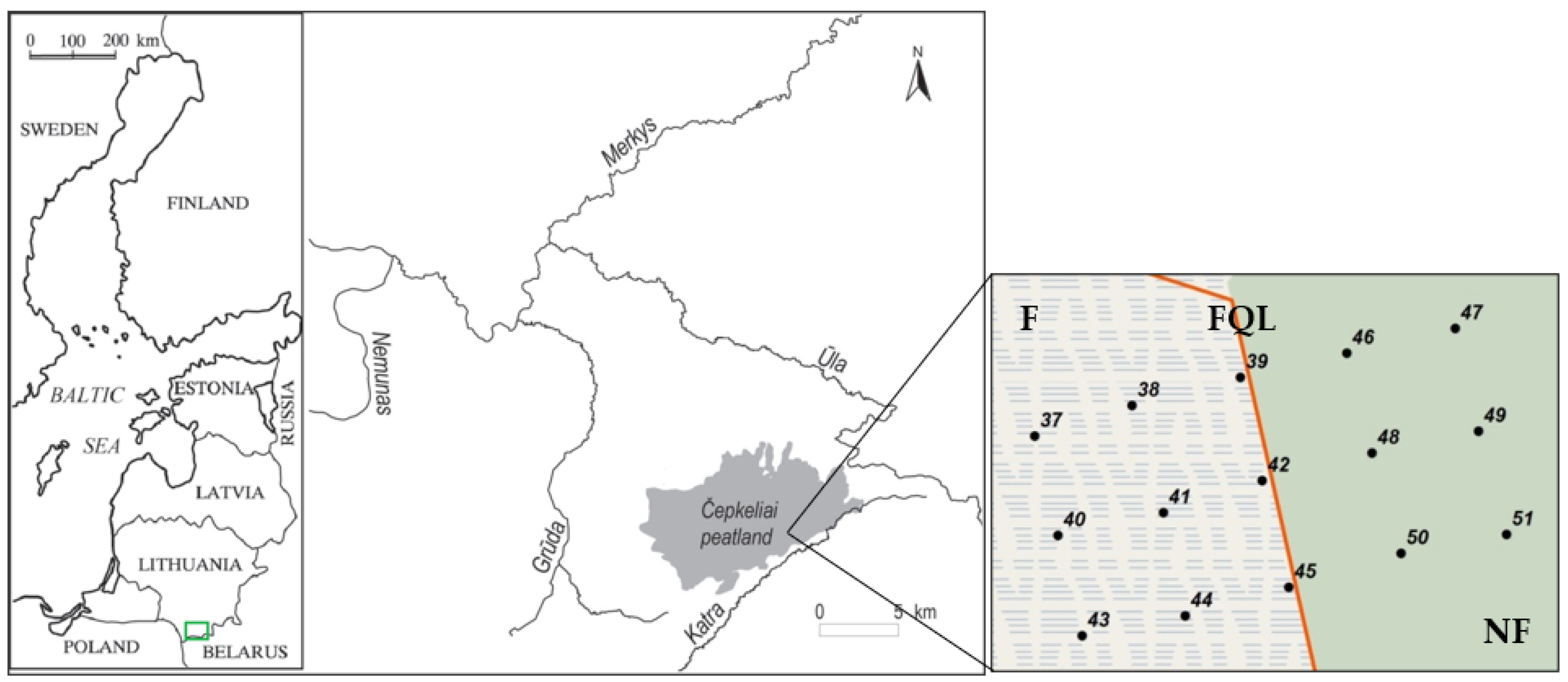
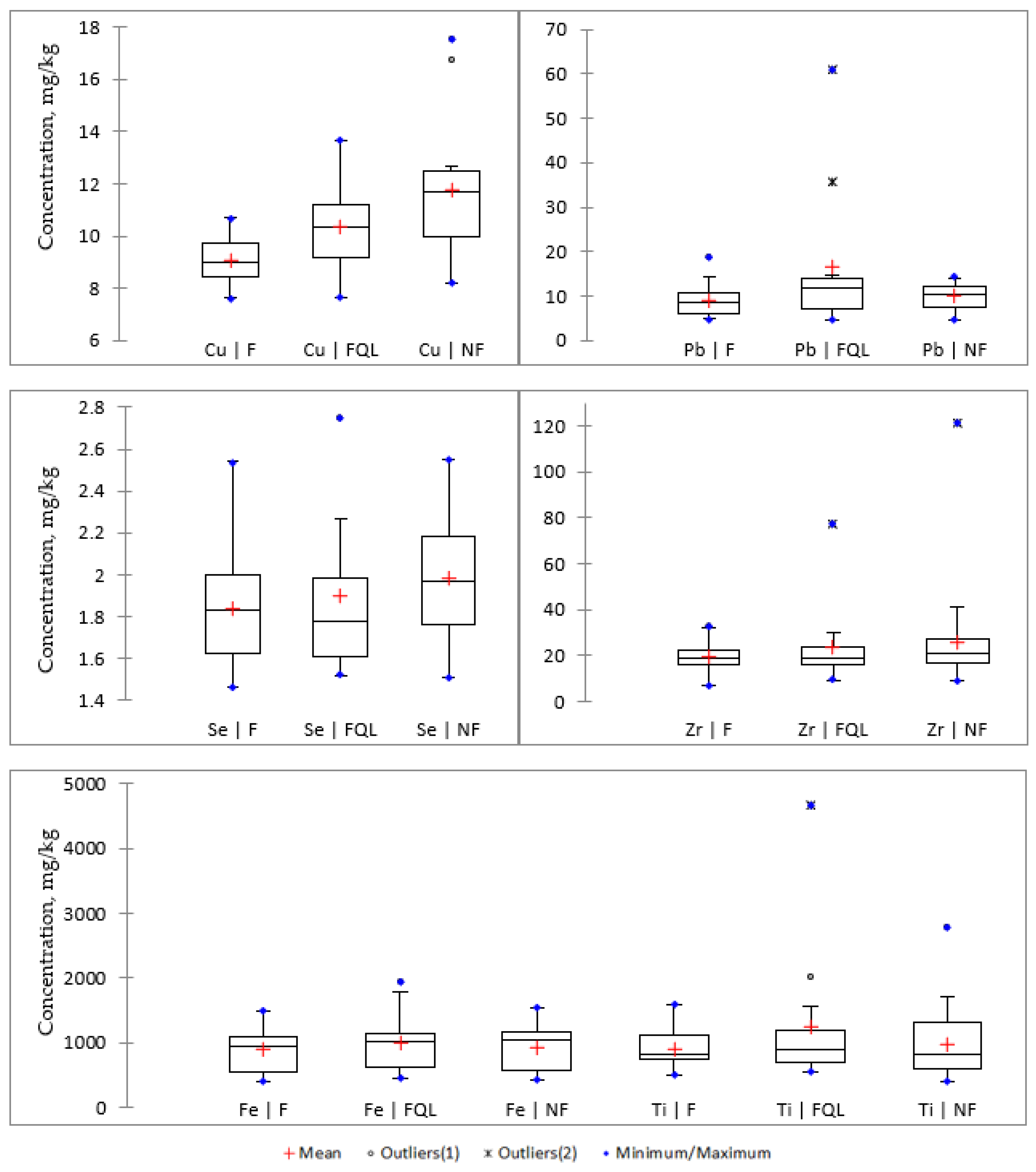
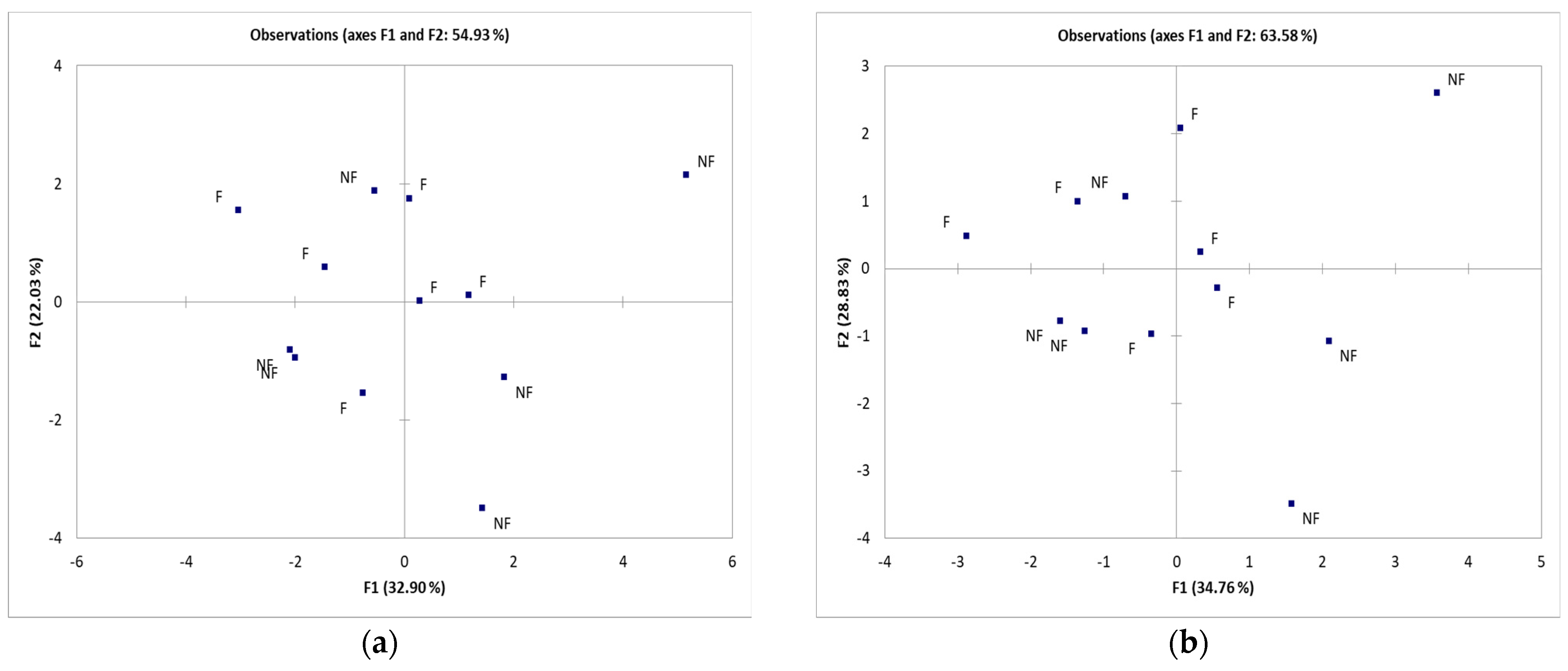
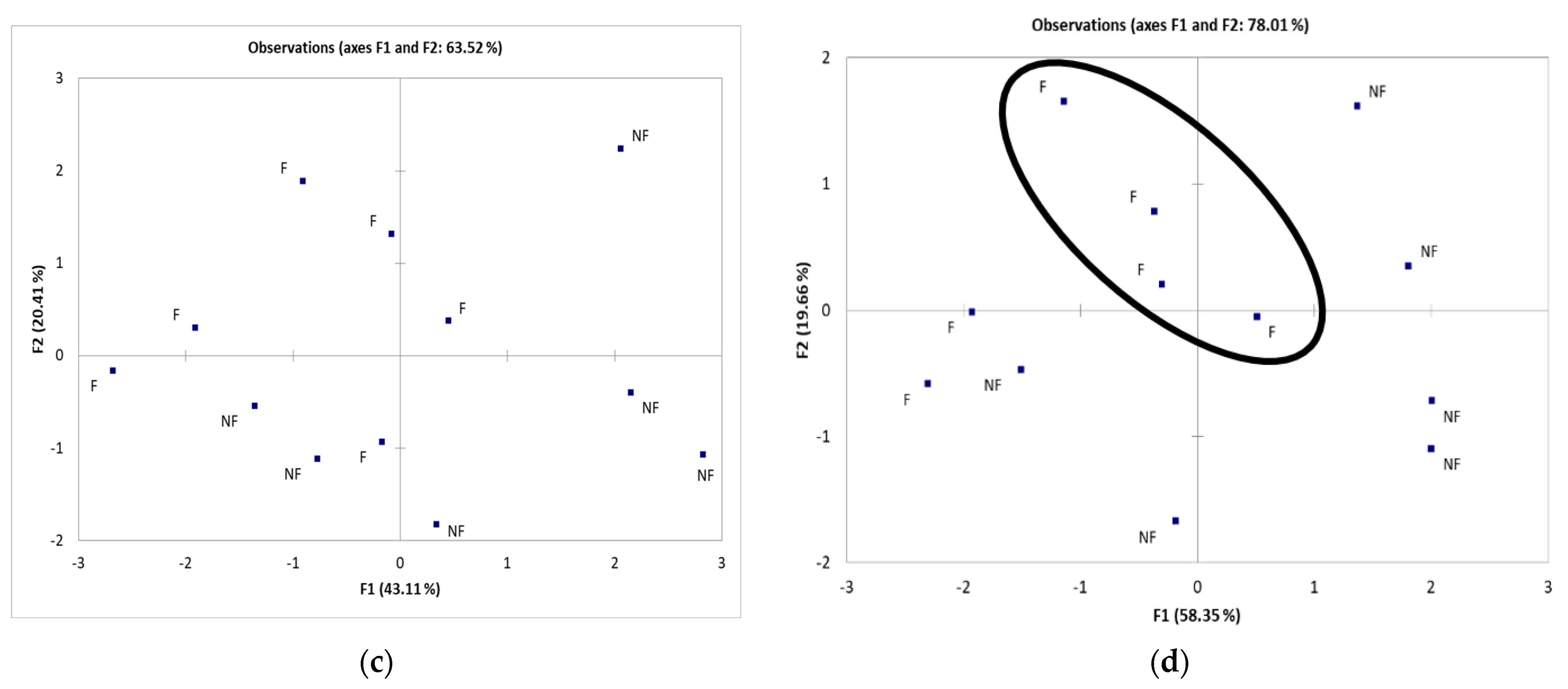
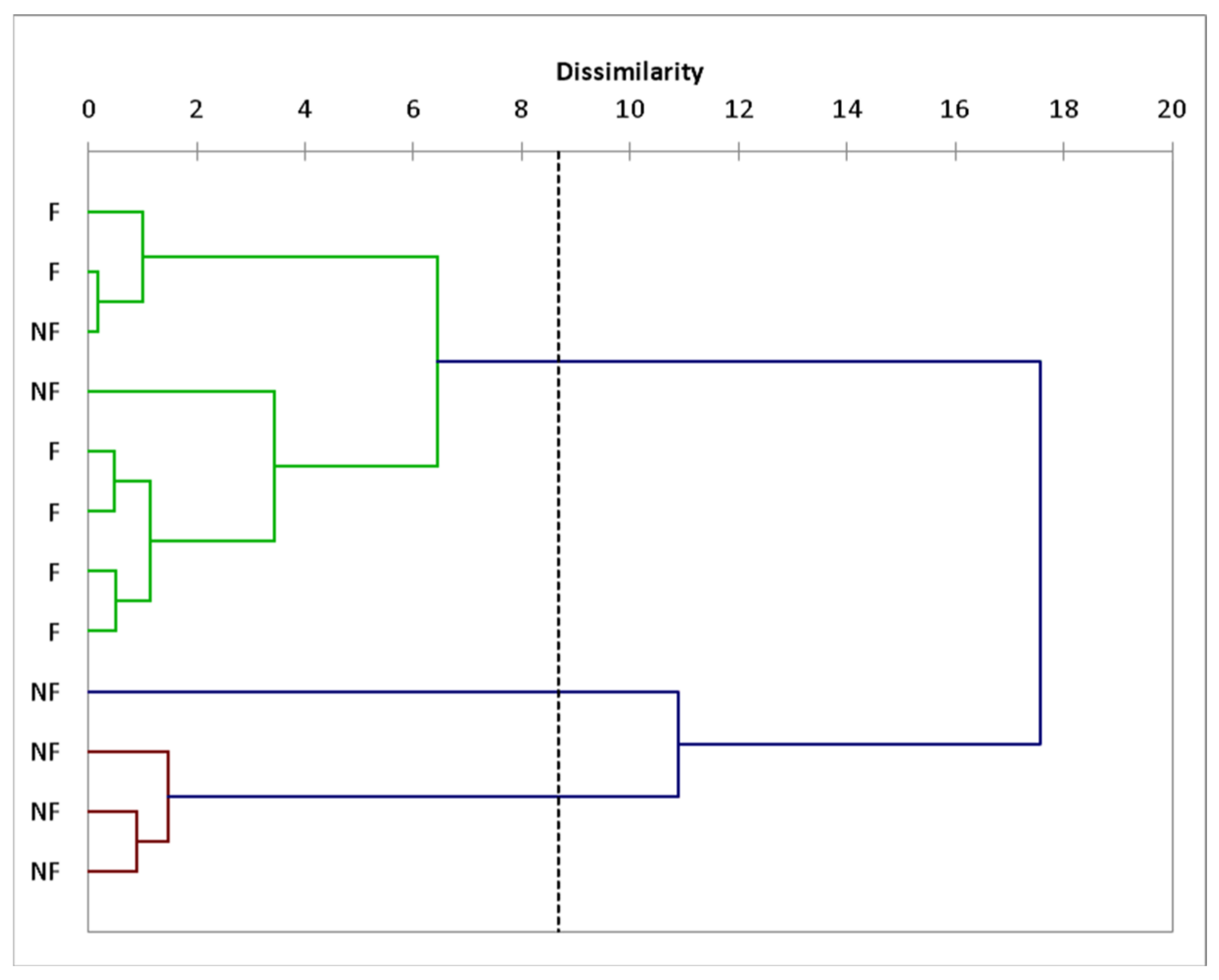
| Variables | Cu | Zr | Pb | Se | Fe |
|---|---|---|---|---|---|
| Cu | 1 | 0.6671 | −0.3408 | 0.7827 | 0.3698 |
| Zr | 1 | −0.0909 | 0.7443 | 0.4126 | |
| Pb | 1 | −0.1940 | −0.1189 | ||
| Se | 1 | 0.6526 | |||
| Fe | 1 |
Disclaimer/Publisher’s Note: The statements, opinions and data contained in all publications are solely those of the individual author(s) and contributor(s) and not of MDPI and/or the editor(s). MDPI and/or the editor(s) disclaim responsibility for any injury to people or property resulting from any ideas, methods, instructions or products referred to in the content. |
© 2023 by the authors. Licensee MDPI, Basel, Switzerland. This article is an open access article distributed under the terms and conditions of the Creative Commons Attribution (CC BY) license (https://creativecommons.org/licenses/by/4.0/).
Share and Cite
Valskys, V.; Kibirkštis, G.; Taminskas, J.; Ulevičius, A.; Ignatavičius, G. Fires in Raised Bog: Their Influence and Changes to Geochemical Elements in Peat Layers. Land 2023, 12, 1948. https://doi.org/10.3390/land12101948
Valskys V, Kibirkštis G, Taminskas J, Ulevičius A, Ignatavičius G. Fires in Raised Bog: Their Influence and Changes to Geochemical Elements in Peat Layers. Land. 2023; 12(10):1948. https://doi.org/10.3390/land12101948
Chicago/Turabian StyleValskys, Vaidotas, Gintautas Kibirkštis, Julius Taminskas, Alius Ulevičius, and Gytautas Ignatavičius. 2023. "Fires in Raised Bog: Their Influence and Changes to Geochemical Elements in Peat Layers" Land 12, no. 10: 1948. https://doi.org/10.3390/land12101948




